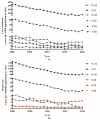Impact of the COVID-19 Pandemic on Malaria Control in Africa: A Preliminary Analysis
- PMID: 36668974
- PMCID: PMC9863638
- DOI: 10.3390/tropicalmed8010067
Impact of the COVID-19 Pandemic on Malaria Control in Africa: A Preliminary Analysis
Abstract
Malaria remains a significant public health concern in Africa, and the emerging coronavirus disease 2019 (COVID-19) pandemic may have negatively impacted malaria control. Here, we conducted a descriptive epidemiological analysis of malaria globally, and preliminarily explored the impact of COVID-19 on the malaria elimination program in regions of Africa (AFR). The present analysis found that there was a vast heterogeneity of incidence of deaths caused by malaria globally in different continents, and the highest malaria burden was observed in AFR. In 2020, there was an obviously increasing trend in the malaria epidemic in AFR, while the other four continents exhibited stable and declining patterns. Historically, malaria has been largely concentrated in high-malaria-burden regions, such as West Africa, and there has been an obvious increasing trend in Nigeria. These data suggest that dynamic changes in the malaria epidemic situation worldwide have primarily originated from AFR, and West Africa has played an important role in the global malaria increase in recent years. Under the coercion of COVID-19, multiple factors have co-driven the increase in malaria in AFR, including insufficient financial investments, a high native malaria burden, weak surveillance systems, limited medical resources, and low socioeconomic development levels. In addition, the shift of medical resources (e.g., health workers and personal protective equipment (PPE), the manufacturing of diagnostic reagents, and drugs) from malaria control to emergency COVID-19 response in the pandemic's early stage caused disruptions, reductions, and delays in pillar malaria control measures, leading to a significant negative impact on malaria control. In particular, a funding shortfall at both the international and domestic levels led to a "significant threat," resulting in vast gaps in access to proven malaria control tools. Although there has been a declining trend in malaria control over time due to COVID-19, the effect still cannot be ignored. Hence, we recommend the implementation of medical and technical resource assistance as a priority strategy to support Africa (West Africa) in order to curb further transmission.
Keywords: Africa; COVID-19; disrupt; epidemiology; malaria.
Conflict of interest statement
The authors have no conflicts of interest to declare.
Figures









References
-
- WHO . World Malaria Report 2020. WHO; Geneva, Switzerland: 2020.
-
- Annan K. In-Host Analysis of Malaria Dynamics in Humans. Open J. Appl. 2020;10:191–209. doi: 10.4236/ojapps.2020.105015. - DOI
-
- Holzschuh A., Gruenberg M., Hofmann N.E., Wampfler R., Kiniboro B., Robinson L.J., Mueller I., Felger I., White M.T. Co-infection of the four major Plasmodium species: Effects on densities and gametocyte carriage. PLoS Negl. Trop. Dis. 2022;16:e0010760. doi: 10.1371/journal.pntd.0010760. - DOI - PMC - PubMed
-
- Moita D., Maia T.G., Duarte M., Andrade C.M., Albuquerque I.S., Dwivedi A., Silva J.C., González-Céron L., Janse C.J., Mendes A.M., et al. A genetically modified Plasmodium berghei parasite as a surrogate for whole-sporozoite vaccination against P. vivax malaria. NPJ Vaccin. 2022;7:163. doi: 10.1038/s41541-022-00585-8. - DOI - PMC - PubMed
Grants and funding
LinkOut - more resources
Full Text Sources

